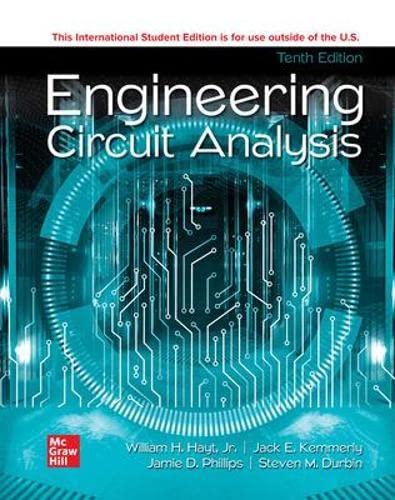

Most ebook files are in PDF format, so you can easily read them using various software such as Foxit Reader or directly on the Google Chrome browser.
Some ebook files are released by publishers in other formats such as .awz, .mobi, .epub, .fb2, etc. You may need to install specific software to read these formats on mobile/PC, such as Calibre.
Please read the tutorial at this link. https://ebooknice.com/page/post?id=faq
We offer FREE conversion to the popular formats you request; however, this may take some time. Therefore, right after payment, please email us, and we will try to provide the service as quickly as possible.
For some exceptional file formats or broken links (if any), please refrain from opening any disputes. Instead, email us first, and we will try to assist within a maximum of 6 hours.
EbookNice Team

Status:
Available4.8
35 reviews
ISBN 13: 9781265853013
Author: William H Hayt, Jr Jack E Kemmerly Jamie D Phillips and Steven M Durbin
Engineering Circuit Analysis
Introduction
1.1 Overview of Text
1.2 Relationship of Circuit Analysis to Engineering
1.3 Analysis and Design
1.4 Computer-Aided Analysis
1.5 Successful Problem-Solving Strategies
Basic Components and Electric Circuits
2.1 Units and Scales
2.2 Charge, Current, Voltage, Power, and Energy
2.3 Voltage and Current Sources
2.4 Ohm’s Law
Voltage and Current Laws
3.1 Nodes, Paths, Loops, and Branches
3.2 Kirchhoff’s Current Law
3.3 Kirchhoff’s Voltage Law
3.4 The Single-Loop Circuit
3.5 The Single-Node-Pair Circuit
3.6 Series and Parallel Connected Sources
3.7 Resistors in Series and Parallel
3.8 Voltage and Current Division
Basic Nodal and Mesh Analysis
4.1 Nodal Analysis
4.2 The Supernode
4.3 Mesh Analysis
4.4 The Supermesh
4.5 Nodal vs. Mesh Analysis: A Comparison
4.6 Computer-Aided Circuit Analysis
Handy Circuit Analysis Techniques
5.1 Linearity and Superposition
5.2 Source Transformations
5.3 Thévenin and Norton Equivalent Circuits
5.4 Maximum Power Transfer
5.5 Delta–Wye Conversion
5.6 Selecting an Approach: A Summary of Various Techniques
The Operational Amplifier
6.1 Background
6.2 The Ideal Op Amp
6.3 Cascaded Stages
6.4 Practical Considerations
6.5 Comparators and the Instrumentation Amplifier
Capacitors and Inductors
7.1 The Capacitor
7.2 The Inductor
7.3 Inductance and Capacitance Combinations
7.4 Linearity and Its Consequences
7.5 Simple Op Amp Circuits with Capacitors
7.6 Duality
7.7 Computer Modeling of Circuits with Capacitors and Inductors
Basic RC and RL Circuits
8.1 The Source-Free RC Circuit
8.2 Properties of the Exponential Response
8.3 The Source-Free RL Circuit
8.4 A More General Perspective
8.5 The Unit-Step Function
8.6 Driven RC Circuits
8.7 Driven RL Circuits
8.8 Predicting the Response of Sequentially Switched Circuits
The RLC Circuit
9.1 The Source-Free Parallel Circuit
9.2 The Overdamped Parallel RLC Circuit
9.3 Critical Damping
9.4 The Underdamped Parallel RLC Circuit
9.5 The Source-Free Series RLC Circuit
9.6 The Complete Response of the RLC Circuit
9.7 The Lossless LC Circuit
Sinusoidal Steady-State Analysis
10.1 Characteristics of Sinusoids
10.2 Forced Response to Sinusoidal Functions
10.3 The Complex Forcing Function
10.4 The Phasor
10.5 Impedance and Admittance
10.6 Nodal and Mesh Analysis
10.7 Superposition, Source Transformations, and Thévenin’s Theorem
10.8 Phasor Diagrams
AC Circuit Power Analysis
11.1 Instantaneous Power
11.2 Average Power
11.3 Maximum Power Transfer
11.4 Effective Values of Current and Voltage
11.5 Apparent Power and Power Factor
11.6 Complex Power
basic engineering circuit analysis 12th edition pdf
basic engineering circuit analysis 12th edition
engineering circuits analysis
basic engineering circuit analysis 11th edition pdf
circuit analysis textbook
electrical engineering circuit analysis
Tags: William H Hayt, Jr Jack E Kemmerly Jamie D Phillips and Steven M Durbin, ENGINEERING, CIRCUIT